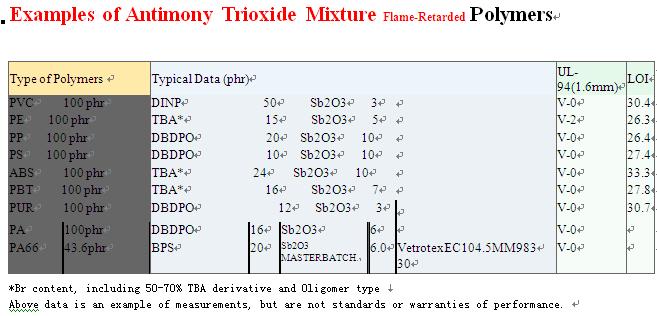Antimony trioxide is not a flame retardant per se, but it is
used as a synergist. It is utilized in plastics, rubbers, textiles,
paper and paints, typically 2-10% by weight, with organochlorine and
organobromine compounds to diminish the flammability of a wide range
of plastics and textiles (IARC, 1989).
Antimony oxides and antimonates must be converted to volatile
species. This is usually accomplished by release of halogen acids at
fire temperatures. The halogen acids react with the antimony-
containing materials to form antimony trihalide and/or antimony halide
oxide. These materials act both in the substrate (condensed phase)
and in the flame to suppress flame propagation. In the condensed
phase, they promote char formation, which acts as a physical barrier
to flame and inhibits the volatilization of flammable materials. In
the flame, the antimony halides and halide oxides, generated in
sufficient volume, provide an inert gas blanket over the substrate,
thus excluding oxygen and preventing flame spread. These compounds
alter the chemical reactions occurring at fire temperatures in the
flame, thus reducing the ease with which oxygen can combine with the
volatile products. It is also suggested that antimony oxychloride or
trichloride reduces the rate at which the halogen leaves the flame
zone, thus increasing the probability of reaction with the reactive
species. Antimony trichloride probably evolves heavy vapours which
form a layer over the condensed phase, stop oxygen attack and thus
choke the flame. It is also assumed that the liquid and solid
antimony trichloride particles contained in the gas phase reduce the
energy content of the flames by wall or surface effects (Troitzsch,
1990).
Other antimony compounds include antimony pentoxide, available
primarily as a stable colloid or as a redispersible powder. It is
designed primarily for highly specialized applications, although
manufacturers suggest it has potential use in fibre and fabric
treatment.
Sodium antimonate (Na2OSb2 O5Ê´H2O) is recommended for
formulations in which deep tone colours are required or where antimony
trioxide may promote unwanted chemical reactions.
Wednesday, January 16, 2008
Antimony trioxide
Subscribe to:
Post Comments (Atom)
Examples of Antimony Trioxide Mixture Flame-Retarded Polymers








0 comment:
Post a Comment